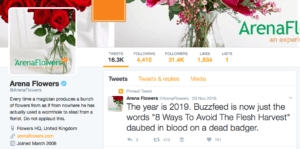The idea for this post started with Arena Flowers on Twitter, just your average old flower shop.
An average small business—except for the fact that they have over 30 thousand followers. We noticed they were using Twitter almost purely to tweet jokes and thought: Wow. Amazing. It’s like they’re marketing without even trying.
But effortless didn’t seem quite like the right word, so we didn’t want to use it in our title. We thought long and hard—what is it that makes a marketing strategy like this so unique? Is there even a word for this—this marketing with a touch of une certaine je ne sais quoi? Successful marketing that’s elusive and seductive and seems almost effortless (but surely isn’t)?
And then we realized: what makes marketing like this so special is that you don’t even feel like you’re being marketed to. That’s why we’re calling it non-marketing, or better yet—alternative marketing. Marketing that doesn’t feel like marketing. Marketing that’s just a little bit different from what you learned in business school.
Whatever you call it, you can’t deny that—terminology aside—it’s simply magic.
1. Arena Flowers Uses Twitter Almost Exclusively for Laughs

Ah, the brand that started it all. The idea for this blog post, that is.
What they do: Dark/weird/funny Twitter is totally a thing, and Arena Flowers is taking advantage of that.
Not “taking advantage of” in a bad way—it’s just that they see there’s an opportunity for genuine, hilarious, and a shared-weirdness-kind of connection among members of this subculture of Twitter and they’re taking it.
Put simply: Arena Flowers tweets strange (and often dark) jokes—sometimes about flowers, sometimes not—and I dare you not to laugh.
Why it works: Arena Flowers isn’t just selling flowers—they’re selling an experience.
They’re selling association with a witty brand. They’re selling themselves as people you want to know. They’re making you think, “If I’m ever in London and need flowers, I’m totally stopping by to meet these crazy people.” And they’re making you laugh while doing it.
And they’re not doing it by accident—it’s well-thought out, it’s genius, and it’s pure disruptive marketing strategy.
To get started using humor in your marketing: Learn how to write jokes. I’m of the belief that anyone with a decent sense of humor can write jokes—all it takes is a bit of practice. Incorporate these jokes into your social media, content, and email strategies.
Craving a more extensive study on writing jokes? Check out Gene Perret’s The New Comedy Writing Step by Step.
2. Budweiser Uses Puppies to Capture Our Hearts

And not just once. Three times. We’re talking about 3 uber-successful commercials here: pup befriends horse, lost pup returns home, and pup waits for owner’s return.
When you watch other commercials for alcohol, what do you see? The Most Interesting Man? People in bars sharing good times? Communion over sporting events? Budweiser opted to do something a little different.
What they do: Storytelling. At its finest.
That’s all well and fun, Budweiser says, but check out this puppy and the stories we’ve built around him.
And that’s what’s surprising. That’s what makes these campaigns special: Budweiser took a step back from their product and its immediate benefits to share with us some touching (seemingly unrelated) stories. And one of these stories even shares an important message about not drinking and driving. Anyone else have a marketing crush on Budweiser now?
Why it works: These adorable stories definitely appeal to emotion, creating a powerful brand association in our minds. Budweiser = love, we think. Budweiser = drinking responsibly. And who wouldn’t love a brand with values like that?
To get started using storytelling in your marketing: Brush up your storytelling skills and start brainstorming on how you can incorporate storytelling into your marketing strategy.
3. Microsoft & Apple Make Peace for the Holidays

What they did: Christmas before last Microsoft put out a commercial featuring Apple and a carol-filled truce between them on Christmas eve. And that’s about all I can say without choking up into tears.
When you’re a diehard Apple gal like me and Microsoft gets you to feel some mad respect and love for them? Amazing. Truce, Microsoft, truce. That was beautiful.
Why it works: Well, if they were trying to make people cry, it worked 100%. There’s a pleasant element of surprise with this one: we’re so used to seeing the two giants pick on each other that a feel-good commercial like this was totally unexpected.
Just like Budweiser, Microsoft plants the seed of brand association in our minds: Microsoft = maturity. Microsoft = friendship. Microsoft even = friendship with competitors. Microsoft takes it a step further than storytelling by including their competitors in the narrative—but in a positive way.
To start using competing brands meaningfully in your marketing: Take a look around you. Who are you competitors? What can you learn from them? What can you admire about them?
Know what makes Dabo Swinney, coach of ACC Champs the Clemson Tigers, so charismatic? He only has good things to say about other coaches. He always sings praises about the coach on the other side of the field, win or lose.
Emulate Dabo and Microsoft next time you’re telling a story about your brand. You don’t have to kneel to your competitors, but you can admire the things they’re doing right in a genuine way. Trust me—it’ll make you look awesome.
4. Dove Sparks Commentary On Beauty Standards

What they do: Dove’s taking a stand against harmful beauty standards with campaigns that encourage us to redefine beauty.
The topic is delicate and Dove’s approach controversial, but that’s not stopping Dove from starting the conversation. Problematic as their approach may be, the inquisitiveness to examine how our society defines beauty is necessary, and this campaign is a wonderful start.
Why it works: Dove’s not just trying to get you to buy a product—they’re trying to get you in on the conversation. They’re trying to get you thinking. They’re putting a mirror in front of our appearance-obsessed society and asking us, “Is this really how we should measure a woman’s worth?”
Another reason this campaign is so cool? Dove actually cares, and it shines through. They’ve gotten criticism to the tune of is this genuine concern, or just a marketing ploy?
But I say that there’s no way a company puts this much marketing power behind—and produces such incredible short films for—a cause they don’t truly believe in. Even if they’re not doing it perfectly, they’re daring to do it at all. And that’s alright by me.
To get started using social commentary in your marketing: Study Dove’s beauty campaign and similar campaigns like Secret’s stand on gender roles. Ask yourself:
- What cause are they trying to spark conversation for?
- How are they doing it? What kind of stories are they telling?
- How are they involving their customers and real-life antidotes to get the conversation going? How can I do the same?
Study your answers. Learn from the experts. Then get brainstorming on your company and how it might fit into the big picture of social change.
5. Metro Trains Melbourne Makes You Think About Death…But In, Like, A Funny Way

Here’s how I picture this one happening: Metro Trains sits down their marketing guy and goes, “Okay, so we need you to talk about death. And warn people about getting hit by trains. And sort of scare them into being more careful. But it also needs to be funny.”
And by god, that genius did it.
What they did: Metro Trains started a genius PSA campaign called Dumb Ways to Die featuring adorable cartoon characters, cheery music, and lovely animation. The message? Don’t jump out in front of trains, because that’s a dumb way to die.
Turns out Melbourne was having a serious issue with train safety and needed a PSA that’d remind people to be smart around trains. But who would’ve guessed that they’d succeed—and succeed so well that they’d sprout a spin-off brand of its own?
I don’t know much about PSA advertising, but can we all just agree that this one wins all the medals, forever and ’til the end of time?
Why it works: Metro Trains takes a boring subject—safety—and makes it fun, adorable, catchy, and just a tad bit gory (but still fun for the kids!). It makes talking about such a dark and avoided topic—death—a bit more approachable.
To get started using death in your marketing (just kidding—let’s say “using lovable characters”): Study some lovable characters in marketing.
Duo, Duolingo’s multilingual owl, is cute and encouraging. Mayhem’s antics in Allstate commercials are ridiculous yet embarrassingly relatable. And the Pillsbury doughboy is just plain scrumptious. Why do they represent the brand so well? Think on that.
It’s not just about the mascots, though—a campaign like this actually wraps up a ton of great strategies into one, like humor, storytelling, and social commentary, all of which we’ve covered so far. So Metro Trains just goes to show us: don’t be afraid to try ‘em all.
In A World with Ads at Every Turn, Alternative Marketing Feels Like Magic
Doesn’t it?
A commercial that doesn’t make you want to change the channel? An ad in the middle of a blog post that you actually want to click on?
Use these alternative marketing techniques to get you there. Because marketing doesn’t have to be desperate, deceptive, or slimy. It can be funny, touching, and it can tell a story. It can spark social commentary. It can even do all 4 at once.
That’s the magic of genuine marketing.
How will you market differently this year?
[text-blocks id=monster-newsletter]





